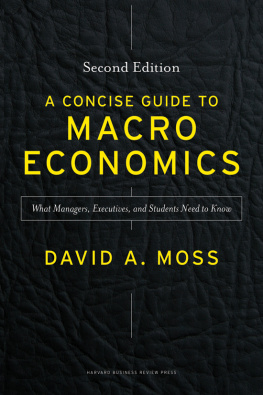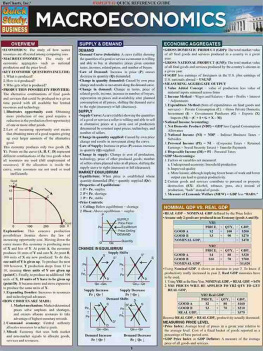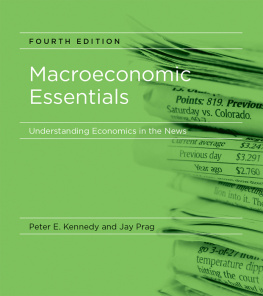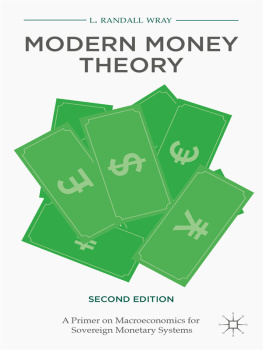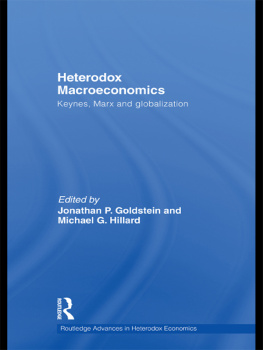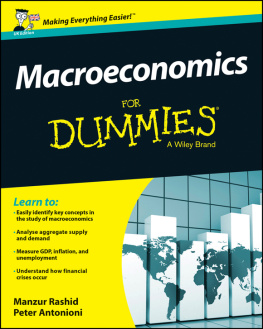Harvard Business Review Press titles are available at significant quantity discounts when purchased in bulk for client gifts, sales promotions, and premiums. Special editions, including books with corporate logos, customized covers, and letters from the company or CEO printed in the front matter, as well as excerpts of existing books, can also be created in large quantities for special needs.
For details and discount information for both print and ebook formats, contact .
Copyright 2014 David A. Moss
All rights reserved
Printed in the United States of America
10 9 8 7 6 5 4 3 2 1
No part of this publication may be reproduced, stored in or introduced into a retrieval system, or transmitted, in any form, or by any means (electronic, mechanical, photocopying, recording, or otherwise), without the prior permission of the publisher. Requests for permission should be directed to , or mailed to Permissions, Harvard Business School Publishing, 60 Harvard Way, Boston, Massachusetts 02163.
The web addresses referenced in this book were live and correct at the time of the book's publication but may be subject to change.
A concise guide to macroeconomics: what managers, executives, and students need to know / David A. Moss. -- Second edition.
1. Macroeconomics. 2. Economic policy. 3. Economic development. 4. Monetary policy--United States. I. Title.
The paper used in this publication meets the minimum requirements of the American National Standard for Permanence of Paper for Publications and Documents in Libraries and Archives Z39.48-1992.
Acknowledgments
This volume began as a note on macroeconomics for my students, and I am deeply indebted to them and to my colleagues in the Business, Government, and the International Economy (BGIE) unit at Harvard Business School for encouraging me to turn the note into a book. I am particularly grateful to Julio Rotemberg, Dick Vietor, and Lou Wells for reading and commenting on the entire manuscript, and to Alex Dyck, Walter Friedman, Lakshmi Iyer, Andrew Novo, Huw Pill, Mitch Weiss, and Jim Wooten for providing vital feedback along the way, and to all my BGIE colleagues over the years, from whom I have learned so much about macroeconomics and how to teach it.
Jeff Kehoe, my editor at Harvard Business Review Press, was extraordinarily supportive at every stage, and offered superb advice on how to recast the original note for a broader audience.
, on GDP accounting, draws heavily on a Harvard Business School case entitled National Economic Accounting: Past, Present, and Future, which I coauthored with Sarah Brennan. Most of what I know about the intricacies of GDP accounting I learned working with Sarah, and I remain exceedingly grateful to her for her commitment to that project and for being such a terrific researcher, coauthor, and friend.
In preparing this second edition, Jonathan Schlefer played a tremendous role, particularly in helping to update data throughout the volume and in clarifying the IMF's new approach to balance of payments accounting. He did a masterful job, and I am enormously appreciative of his contributions, without which there would be no second edition.
Finally, I wish to thank my parents, who, in so many ways, inspired this book by teaching me not to lose sight of the big picture; and my wife and daughtersAbby, Julia, and Emilyfor their unending support and patience and for making every day so much fun!
Introduction
Macroeconomic forces affect all of us in our daily lives. Inflation rates influence the prices we pay for goods and services and, in turn, the value of our incomes and our savings. Interest rates determine the cost of borrowing and the yield on bank accounts and bonds, while exchange rates affect our command over foreign products as well as the value of our foreign assets. And all of this represents just the tip of the iceberg. Numerous macro variablesranging from unemployment to productivityare equally important in shaping the economic environment in which we live.
For most business managers, a basic understanding of macroeconomics allows a more completeas well as a more nuancedconception of market conditions, on both the demand side and the supply side. It also ensures that they are better equipped to anticipate and to respond to major macroeconomic events, such as a sudden depreciation of the real exchange rate or steep hike in the federal funds rate.
Although managers can enjoy success even if they don't truly understand these sorts of macro variables, they have the potential to outperform their competitorsto see hidden opportunities and to avoid unnecessary (and sometimes very costly) mistakesafter incorporating basic macro concepts and relationships into their management toolbox. In the 1990s, for example, managers who knew how to read and interpret a balance of payments statement had a definite leg up in dealing with the Mexican and Asian currency crises. Similarly, those who understood the essential dynamic of a bank runand the power of negative expectationswere better positioned to cope with the financial crisis of 20072009.
Nor is the practical value of macroeconomics confined to business. A basic understanding of the subject is important to us as consumers, as workers, as investors, and even as voters. Whether our elected officials (and the individuals they appoint to lead crucial agencies, such as the Federal Reserve and the Treasury Department) manage the macro economy well or poorly obviously has great significance for our quality of life, both now and in the future. Whether a large budget deficit is advantageous or disadvantageous at a particular moment in time is something that voters should be able to evaluate for themselves.
Unfortunately, even many well-educated citizens have never studied macroeconomics. And those who have studied the subject too often learned more about how to solve artificial problem sets than about the true fundamentals of the macro economy. Macroeconomics is frequently taught with a heavy focus on equations and graphs, which, for many students, obscure the essential ideas and intuition that make the subject meaningful. This book attempts to provide a conceptual overview of macroeconomics, emphasizing essential principles and relationships, rather than mathematical models and formulas. The purpose is to convey the fundamentalsthe building blocksand to do so in a way that is both accessible and relevant.
The approach employed here is one I have helped to develop over the past two decades at Harvard Business School. In fact, I drafted the first version of this book as a primer for my students, and it has since been adopted as required reading in many programs at HBS. Although the approach is quite different from what one would find in a standard macro textbook (graduate or undergraduate), it is an approach that we have found to be very effective and that has also been well received by students and executives alike.
As the remainder of this volume makes clear, macroeconomics may be thought of as resting on three basic pillars: output, money, and expectations. Because output is the central pillar, we begin with that topic in of the book, which covers the fundamentals of macroeconomics in as compact a form as possible.
For readers interested in digging a bit deeper, surveys the topic of exchange rates, focusing on factors that are thought to drive currencies to appreciate or depreciate. Although the path of an exchange rate, like the trajectory of a stock, is notoriously difficult to predict, there are certainly a number of important economic relationships one should take into account whenfor either personal or business reasonsa prediction is required.

